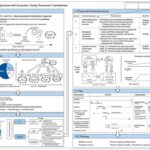The Powertrain Control Module (PCM) is the brain of your 2013 Ford Explorer, responsible for managing engine and transmission functions. Knowing its location can be crucial for diagnostics and repairs. This article will guide you to the PCM’s location and provide essential information about this critical component.
Pinpointing the PCM in Your 2013 Ford Explorer
The PCM in a 2013 Ford Explorer is typically located under the hood, on the passenger side, near the firewall. It’s often housed in a black plastic box and mounted to the fender well. You might need to remove some components for clear access, such as the air filter box or battery tray. Look for a box with multiple wiring harnesses connected to it.
Understanding the PCM’s Role
The PCM constantly monitors various sensors throughout the engine and transmission, processing this data to adjust engine timing, fuel delivery, and transmission shifting. A malfunctioning PCM can lead to a variety of issues, including:
- Poor fuel economy: The PCM might not be optimizing fuel delivery.
- Rough idling or stalling: Incorrect engine timing or fuel mixture can cause these problems.
- Transmission shifting problems: The PCM controls shift points and could be causing erratic behavior.
- Check engine light illumination: The PCM triggers the check engine light when it detects a problem.
Replacing or Repairing the PCM
If your 2013 Ford Explorer’s PCM is faulty, it will likely need to be replaced or reprogrammed. This is a complex procedure that often requires specialized tools and expertise. While some mechanically inclined individuals might attempt this themselves, it’s generally recommended to consult a qualified mechanic or Ford dealership for PCM related issues. They have the necessary diagnostic equipment and experience to properly diagnose and address PCM problems.
Important Considerations
- Disconnecting the battery: Before working near the PCM, always disconnect the negative battery terminal to prevent electrical damage.
- Proper handling: The PCM is sensitive to static electricity. Handle it with care and avoid touching the connectors.
- Professional help: Seek professional assistance if you’re unsure about any aspect of PCM diagnosis or replacement.
In conclusion, locating the PCM in your 2013 Ford Explorer is the first step in diagnosing potential engine or transmission issues. While visually identifying the module is relatively straightforward, addressing any problems with the PCM often requires professional expertise. Remember to exercise caution when working near the PCM and consult a qualified technician for any complex repairs or replacements.
